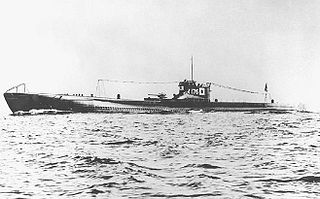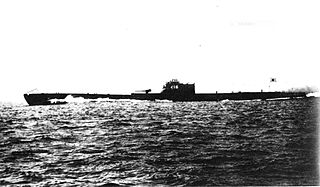Imperial Japanese Navy submarines originated with the purchase of five Holland type submarines from the United States in 1904. Japanese submarine forces progressively built up strength and expertise, becoming by the beginning of World War II one of the world's most varied and powerful submarine fleets.

I-58, later I-158, was an Imperial Japanese Navy Kaidai-class cruiser submarine of the KD3A sub-class commissioned in 1928. During World War II, she supported Japanese forces during the invasion of Malaya in December 1941 and was instrumental in tracking Force Z, the two British capital ships that attempted to intercept the Japanese invasion forces, so they could be sunk by torpedo bombers. She sank four Dutch merchant ships in early 1942 during the Dutch East Indies campaign and then was transferred to the Central Pacific in May 1942 to support the fleet during the Battle of Midway in early June 1942. Upon her return to Japan in July 1942, she became a training ship until early 1945 when she was modified to serve as a carrier for kaiten manned suicide attack torpedoes. She surrendered to the Allies at the end of the war and was scuttled in 1946.

USS Gilmore (DE-18) was an Evarts-class short-hull destroyer escort in the service of the United States Navy.
I-177 was an Imperial Japanese Navy Kaidai-type cruiser submarine of the KD7 subclass commissioned in 1942. She served during World War II, patrolling off Australia, taking part in the New Guinea campaign, operating in the North Pacific, and participating in the Palau campaign before she was sunk by the destroyer escort USS Samuel S. Miles (DE-183) in 1944, with no survivors.

I-10 was an Imperial Japanese Navy Type A1 submarine that served during World War II. Designed as a submarine aircraft carrier, she was commissioned in 1941 and supported the attack on Pearl Harbor, operated in the Indian Ocean — including support for the 1942 midget submarine attack on Diego Suarez — and in the New Caledonia and New Zealand areas, and took part in the Guadalcanal campaign and Marianas campaign before she was sunk in 1944 during her seventh war patrol.
I-11 was an Imperial Japanese Navy Type A1 submarine that served during World War II. Designed as a submarine aircraft carrier and submarine squadron flagship, she was commissioned in 1942. She participated in the Guadalcanal campaign and patrolled off Australia, New Caledonia, and the Ellice Islands before she disappeared in 1944 during her sixth war patrol. She badly damaged the Royal Australian Navy light cruiser HMAS Hobart in 1943.

Japanese Submarine I-178 was a Kaidai type of cruiser submarine that saw service during World War II in the Imperial Japanese Navy. Commissioned on December 26, 1942, I-178 was a KD7 sub-class boat that sailed on just two patrols off the east coast of Australia during 1943, going missing sometime after 17 June 1943.

I-65, later renumbered I-165, was an Imperial Japanese Navy Kaidai type cruiser submarine commissioned in 1932. A KD5 sub-class submarine, she served during World War II, supporting Japanese forces in the invasion of Malaya and the Dutch East Indies campaign, participating in the Battle of Midway, and patrolling in the Indian Ocean and Pacific Ocean before she was sunk in 1945. In 1944, her crew committed a war crime, massacring the survivors of the merchant ship Nancy Moller.

I-55, later renumbered I-155, was an Imperial Japanese Navy Kaidai-class cruiser submarine of the KD3A sub-class commissioned in 1927. Early in World War II, she supported Japanese forces in the invasion of Malaya and the Dutch East Indies campaign before assuming training duties in Japan, interrupted briefly in 1943 by her participation in the Aleutian Islands campaign. She became a kaiten manned suicide attack torpedo carrier in 1945 before surrendering at the end of the war. She was scuttled in 1946.

I-54, later I-154, was an Imperial Japanese Navy Kaidai-class cruiser submarine of the KD3A sub-class commissioned in 1927. During World War II, she conducted three war patrols, supporting Japanese forces during the invasion of Malaya in December 1941 and the Dutch East Indies campaign in early 1942, then was assigned to training duties until she was decommissioned in 1944. She was scuttled in 1946.
The Japanese submarine I-179 was a Kaidai type cruiser submarine of the KD7 sub-class built for the Imperial Japanese Navy (IJN) during the 1940s. She was lost with all hands when a valve was accidentally left open during her sea trials in July 1943. Her wreck was later salvaged and scrapped in 1957.
I-181 was an Imperial Japanese Navy Kaidai-type cruiser submarine of the KD7 sub-class commissioned in 1943. During World War II, she conducted two war patrols, rescued the United States Marine Corps ace Gregory "Pappy" Boyington, and took part in the New Guinea campaign before American warships sank her in January 1944.
I-183 was an Imperial Japanese Navy Kaidai type cruiser submarine of the KD7 sub-class commissioned in 1943. During World War II, she was sunk with all hands by United States Navy fleet submarine in April 1944.

I-75, later I-175, was an Imperial Japanese Navy Kaidai-type cruiser submarine of the KD6B sub-class commissioned in 1938. During World War II, she took part in the attack on Pearl Harbor, the Battle of Midway, the Guadalcanal campaign, the Aleutian Islands campaign, and the Gilbert and Marshall Islands campaign and operated off Australia, before she was sunk in 1944 during her tenth war patrol. She is best known for sinking the United States Navy escort carrier USS Liscome Bay on 24 November 1943.

I-16 was one of five Type C cruiser submarines of the C1 sub-class built for the Imperial Japanese Navy, Commissioned in 1940, she deployed a midget submarine for the attack on Pearl Harbor and for an attack on ships at Diego-Suarez in Madagascar, conducted an anti-shipping patrol in the Indian Ocean, and took part in the Guadalcanal campaign, New Guinea campaign, and Bougainville campaign before she was sunk in May 1944.
I-66, later I-166, was a Kaidai-class cruiser submarine of the KD5 sub-class completed for the Imperial Japanese Navy in 1932. She served during World War II, supporting the Japanese invasion of Malaya and the invasion of Sarawak, taking part in the Battle of Midway, and conducting numerous war patrols in the Indian Ocean before was sunk in July 1944.
I-2 was an Imperial Japanese Navy J1 type cruiser submarine commissioned in 1926. She served in the Second Sino-Japanese War and World War II. During the latter conflict she operated in support of the attack on Pearl Harbor, conducted anti-shipping patrols in the Indian Ocean, supported the Indian Ocean raid, and took part in the Aleutian Islands campaign, the Guadalcanal campaign, Operation Ke, and the New Guinea campaign before she was sunk in April 1944.

I-33 was an Imperial Japanese Navy B1 type submarine. Completed and commissioned in 1942, she served in World War II, making one war patrol that included the Battle of the Eastern Solomons, before sinking accidentally in September 1942. Refloated and repaired, she sank again in a diving accident during post-repair sea trials in June 1944.
Ro-49 was an Imperial Japanese Navy Kaichū type submarine of the K6 sub-class. Completed and commissioned in May 1944, she served in World War II and patrolled off the Philippines and the Ryukyu Islands. She was lost during her third war patrol sometime in late March or April 1945.
Ro-104 was an Imperial Japanese Navy Ro-100-class submarine. Completed and commissioned in February 1943, she served in World War II, operating in the Aleutian Islands campaign, New Guinea campaign, and Solomon Islands campaign before she was sunk in May 1944 during her tenth war patrol.








